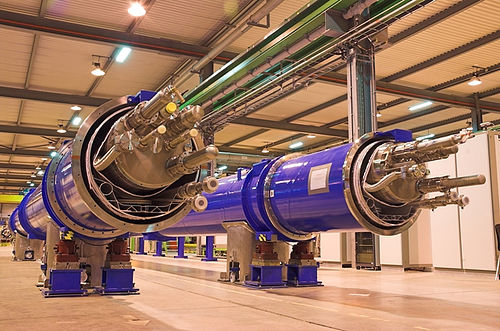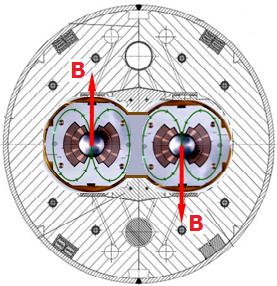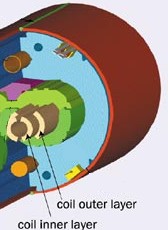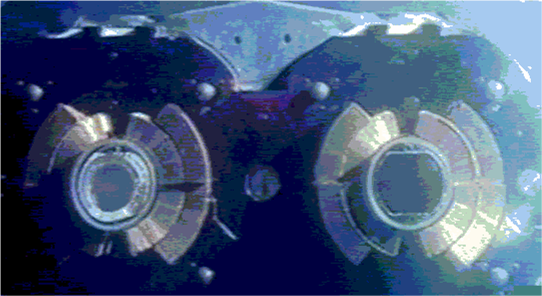Taking a closer look at LHC
1232 magnetic dipoles (14,3 m long and weighs around 35 tons) placed along the beam path will produce the force which must bend the protons trajectory on the eight LHC arcs.

|
An ingenious design of the magnetic field in every dipole generates a vector B on each pipe opposite in direction to that of the other pipe. This configuration is called: 2-in-1
|
 |
Curving the beam's path is achieved by the magnetic field of dipole magnets. This is becausethe magnetic force (Lorentz Force) exerted on charged particles is always perpendicular to their velocity, perfect for curving the trajectory.

Since the centripetal force Fc is the Lorentz Force:
Fc = q×v×B
B = Fc /(q×v)
F = 4·10-10 N , q = 1,602·10-19 C and v ~ c
B ~ 8.33 T
(100000 times Earth’s magnetic field)
If the LHC had been made of conventional magnets, it would have needed to be 120 km long to achieve the same energies and its electricity consumption would have been phenomenal.
|
The dipole magnet is wound of a special cable superconductives, containing 28 and 36 strands on the inner and outer coil layers, respectively. The strands of the cable are made of Nb-Ti filaments of 6 and 7 mm in diameter (inner and outer layer of the coil) and are embedded in a copper matrix. During the LHC operation at 1.9 K, the two counter-rotating beams follow flat circular trajectories along the 14.3 m long active part of each dipole. The two orbits are separated by 194 mm which is the nominal distance between the coil axes. That distance is 420 mm in RF cavities, whereas both beams use a unique pipe when going through detectors. |
|
|
AUTHORS Xabier Cid Vidal, PhD in experimental Particle Physics for Santiago University (USC). Research Fellow in experimental Particle Physics at CERN from January 2013 to Decembre 2015. He was until 2022 linked to the Department of Particle Physics of the USC as a "Juan de La Cierva", "Ramon y Cajal" fellow (Spanish Postdoctoral Senior Grants), and Associate Professor. Since 2023 is Senior Lecturer in that Department.(ORCID). Ramon Cid Manzano, until his retirement in 2020 was secondary school Physics Teacher at IES de SAR (Santiago - Spain), and part-time Lecturer (Profesor Asociado) in Faculty of Education at the University of Santiago (Spain). He has a Degree in Physics and a Degree in Chemistry, and he is PhD for Santiago University (USC) (ORCID). |
CERN CERN Experimental Physics Department CERN and the Environment |
LHC |
IMPORTANT NOTICE
For the bibliography used when writing this Section please go to the References Section
© Xabier Cid Vidal & Ramon Cid - rcid@lhc-closer.es | SANTIAGO (SPAIN) |





